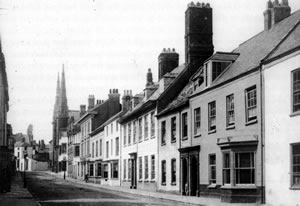About the Trust
The Work of the Bridge Trust
For details of the Trustees, legal details and accounts...go here
The work of the Trust can be divided into two � Building and Funding.
Building
The bridge was the main building the trustees spent their funds on. Most of the spending went on maintenance but occasionally money was expended on deliberate damage as in 1802 when �...malicious persons have repeatedly thrown down the Coping Stones of the Bridge and...two persons should...keep watch in the Watch House�. The Trust erected a sentry box.
Over the years the Trust has purchased a wide variety of properties and townspeople have left property to the Trust for the upkeep of the bridge. This has meant that for a long time the Trust had been the largest owner of property in the town and surroundings. The trustees have also been responsible for building new properties.

The most important of these was Bridgeland Street. In the 1690s they decided to develop some rough land lying along the edge of the Pill estuary at the then northern limit of Bideford. As they laid out this new street they also extended the Quay from the southern limit of Jubilee Square to the bottom of Bridgeland Street which allowed the town's economic trade to flourish.
The famous author Daniel Defoe visited Bideford in the early eighteenth century and he noted of Bridgeland Street that it was 'broad as the High Street of Exeter.
In 1758 the Trust built the original town hall at the western end of the bridge and in 1882 the old structure was replaced with today's Bridge Buildings. Both buildings housed the Trust's offices along with at different times the Grammar School, the Library, the School of Science and Art and offices. The Bridge Buildings were eventually sold to the district council.
In 1761 the trustees purchased an old public house on the Quay known as the 'Fox and Goose'. The building became known as the Mansion House and for the next hundred years or so provided the town with a theatre, a ballroom and a centre for social occasions of all kinds.
In 1785 we find the Trust giving £150 'together with whatever more may hereafter be found necessary' to St.Mary's church to carry out large scale building works. In the 1880s the trustees gave a site in the High Street for a new post office.
Many other developments owe their genesis to the Trust including the Old Town cemeteries which date from 1742. Other schemes included the houses at Victoria Gardens and those at Marland Terrace along with various other smaller developments.
Funding
As noted before the Trust's income comes from its property holdings and this money is spent in two ways: on maintaining and modernising its buildings and on funding local groups and individuals. The trustees set up a Commercial School to train young men in mathematics, navigation and writing - the skills needed to become merchants and shipowners. The trustees also paid the teacher's salary of £12.10.0.
Similarly when the Church of England established a National or 'Bell's' School in 1823 the trustees gave the site in Old Town (where the Fire Station now stands) and provided the annual payment of £35 to pay the teachers. In 1844 the trustees gave 'A plot of land at the corner of Honestone Street for erecting suitable premises to carry on the work of an Infant School recently started.' In 1896 when the School of Art was opened on the Quay the trustees helped finance its building and paid £24 a year towards supporting the teaching there.
Under a long standing commitment the Trust gave £1000 a year to the old Grammar School this being continued to Bideford College when it was set up. Some £50,000 was given to the College to fund a computer teaching suite and when the new College building was given the go-ahead the Trust gave £500,000 to help provide even better facilities in the new building.
All students living with the parish of Bideford going on to higher education receive a sizeable book grant and annual bursaries are also available. Local students not living in the parish are eligible for 'hardship' grants if they apply detailing their situation. Those going on educational trips who have difficulty raising the required payments are also helped.
Poverty in Bideford was another target for the trustees. In 1766, for example, £20 was given to buy flour for the poor 'at this time of dearness of Corn' � with some £90 being spent the following year. In 1800 £40 worth of soup was distributed to the hungry whilst in 1831 at a time when unemployment and thus hardship was rife in the town 2 acres of land in Northdown Lane (as it was then called) was turned into allotments.
The Trust have also been involved in supporting medical charity: vaccinations to tackle smallpox. In 1784 they paid for a poor 'lunatic' to go for treatment in London's Bedlam Hospital and when the hospital in Meddon Street was built in the 1887 they helped fund its construction.
In recent years sums have been given to the Chestnut Appeal (prostate cancer), to provide a hospital minibus and to fund a relatives' bed in the Derriford treatment centre. The Trust also helps supply wheelchairs and disability adaptations for individuals.
In the past sets of tools were purchased for apprentices but today Business Start-Up grants are offered and quite a few local businesses can thank the Trust for these funds which have successfully set them on their way.
One rather odd payment came in the 1720s when the trustees provided funds for a bowling green near the top of High Street � and which they continued to support for some 40 years at least. Other funds have gone to help a wide range of local sporting and social groups, to provide the new toilet block in Victoria Park, the Quayside fountain to mark the Queen's Jubilee and to help pay for the Port Memorial improvements. A taxi voucher scheme for the elderly and disabled is in place and all local primary schools have swimming lessons for their pupils paid for by the Trust.
There are many more deserving causes the Trust supports � and it is clear that Bideford benefits hugely from the Trust. Long may the Trust continue � Bideford and its citizens would be by far the poorer without it.

